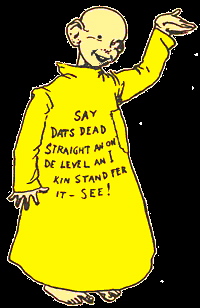This morning I discovered that yesterday was not only Cinco de Mayo, but also National Cartoonists Day. In honor of the occasion, three cartoons for today. Then some account of Cartoonists Day, which leads to the early newspaper cartoon featuring the Yellow Kid.
1. Three cartoons today. Two (a Rhymes With Orange and a Zippy) on means of communication, plus a Zits on what counts as retro to whom.
A parody of Dr. Seuss’s Cat in the Hat, with chat instead of hat.
Old-fashioned communication, on paper (“snail mail”, stressing the slowness) or face-to-face (“oral download”!), vs. trendy means of communication (of five types); the difference is a recurrent theme in Zippy the Pinhead, and also in Zits.
(Odds and ends: as usual, the proper names, which I won’t try to unpack here. Anyone who would like to take a bash at the first two — I assume that Einstein Feinstein is, as Zippy names go, straightforward — is welcome to. The egg is probably just a bit of surrealism. Credenza is there because it’s a delicious word. And we get Judge Judy again.)
2. National Cartoonists Day and the Yellow Kid. The second is the source of the first. See the Wikipedia page (with the crucial bit boldfaced):
The Yellow Kid was the name of a lead comic strip character that ran from 1895 to 1898 in Joseph Pulitzer’s New York World, and later William Randolph Hearst’s New York Journal. Created and drawn by Richard F. Outcault in the comic strip Hogan’s Alley (and later under other names as well), it was one of the first Sunday supplement comic strips in an American newspaper, although its graphical layout had already been thoroughly established in political and other, purely-for-entertainment cartoons.
… Mickey Dugan, better known as The Yellow Kid, was a bald, snaggle-toothed boy who wore an oversized yellow nightshirt and hung around in a slum alley typical of certain areas of squalor that existed in late 19th-century New York City. Hogan’s Alley was filled with equally odd characters, mostly other children. With a goofy grin, the Kid habitually spoke in a ragged, peculiar slang, which was printed on his shirt, a device meant to lampoon advertising billboards.
The character who would later become the Yellow Kid first appeared on the scene in a minor supporting role in cartoon panel published in Truth magazine in 1894 and 1895. The four different black-and-white single panel cartoons were deemed popular, and one of them, Fourth Ward Brownies, was reprinted on 17 February 1895 in Joseph Pulitzer’s New York World, where Outcault worked as a technical drawing artist. The World published another, newer Hogan’s Alley cartoon less than a month later, and this was followed by the strip’s first color printing on 5 May 1895. Hogan’s Alley gradually became a full-page Sunday color cartoon with the Yellow Kid (who was also appearing several times a week) as its lead character.
Two images of the Yellow Kid:
 (#3)
(#3)
Hogan’s Alley is from what some have called “the platinum age” of the comics (preceding and surpassing the golden age). Besides the Yellow Kid, characters from this time include Little Nemo, Krazy Kat, and Micky Mouse.



